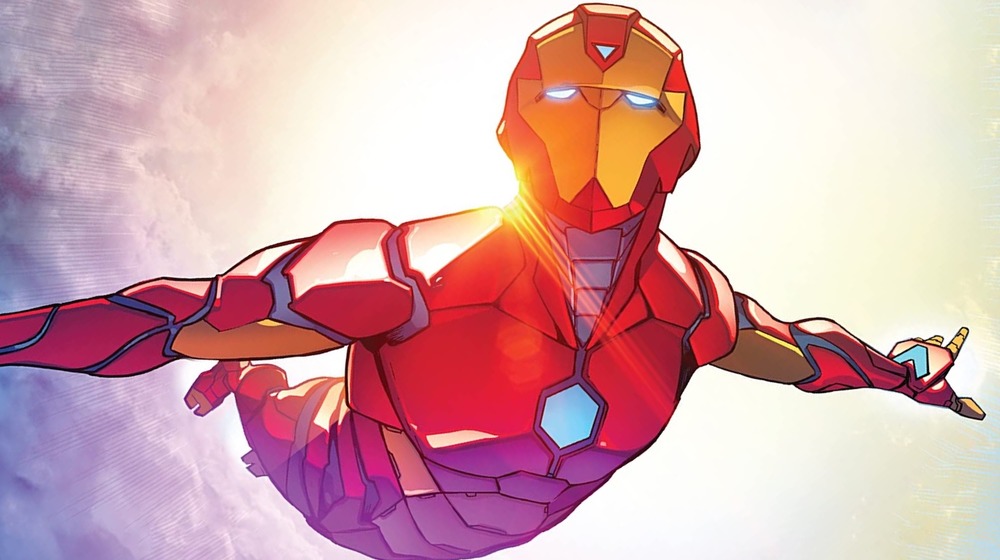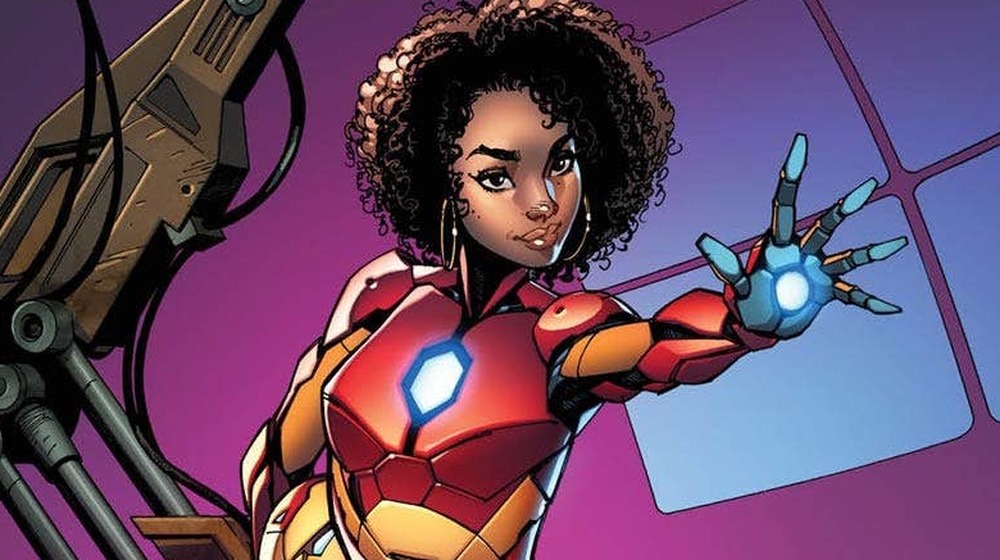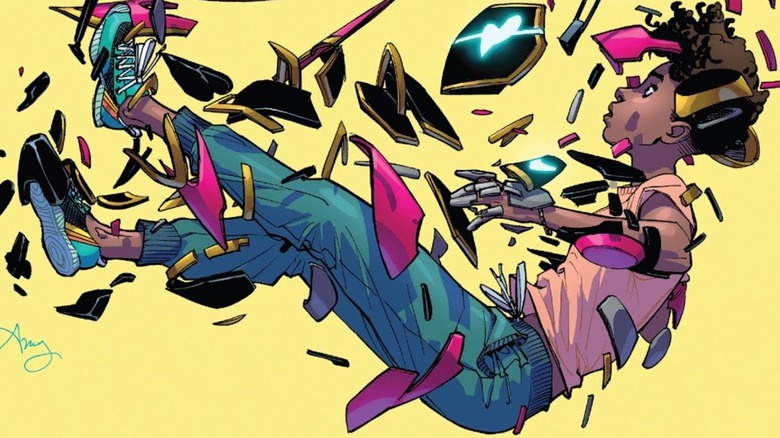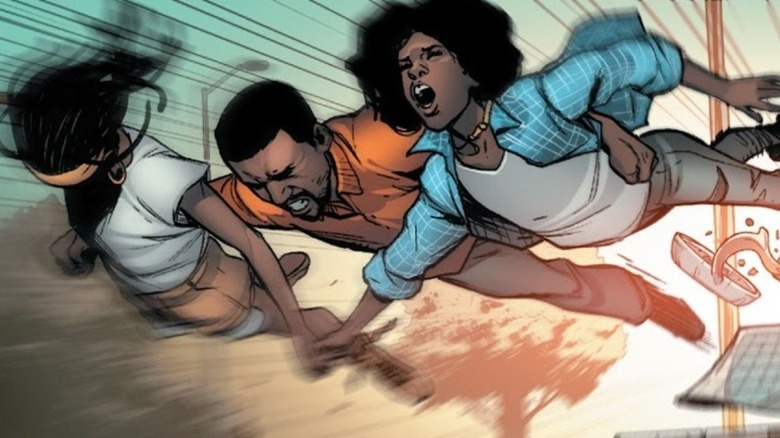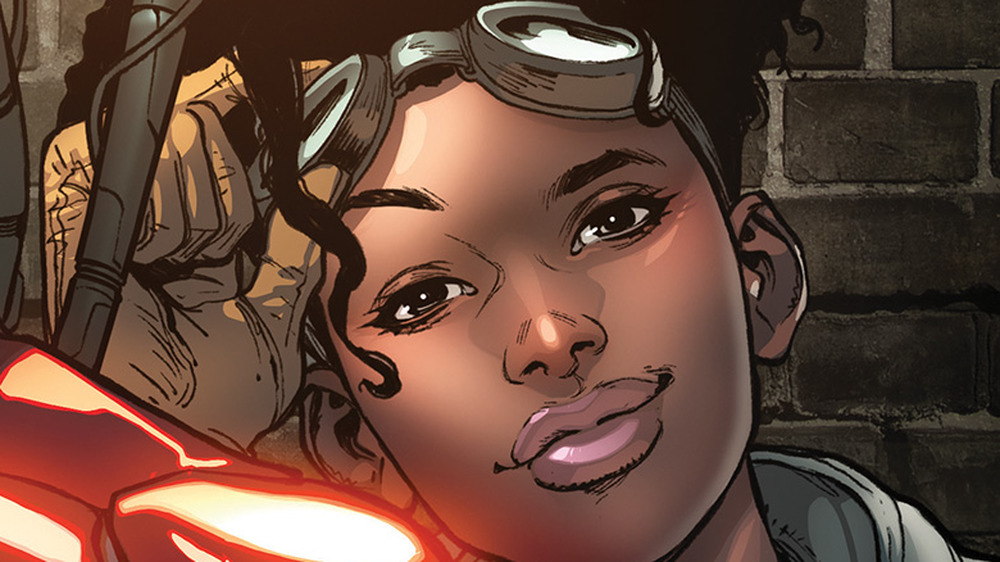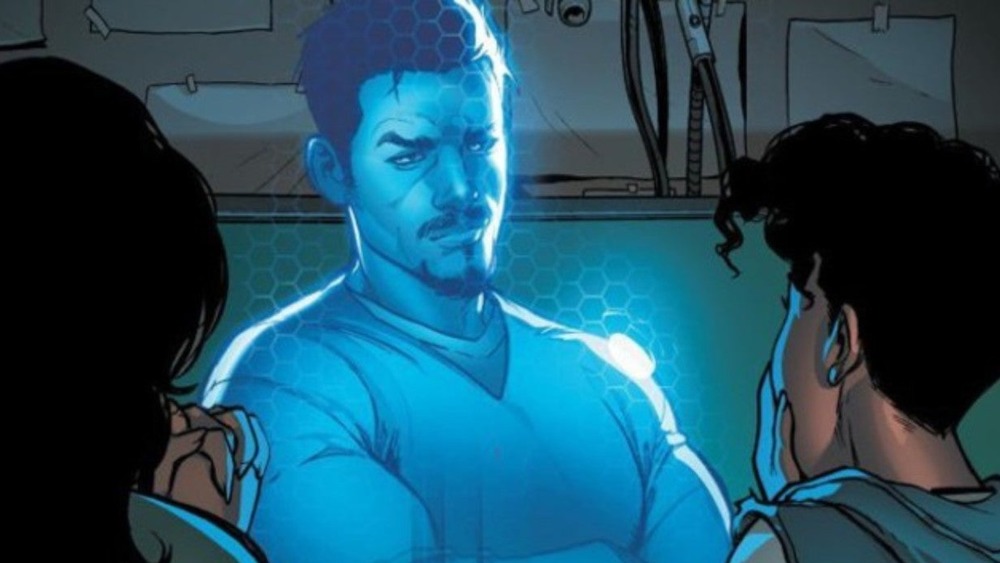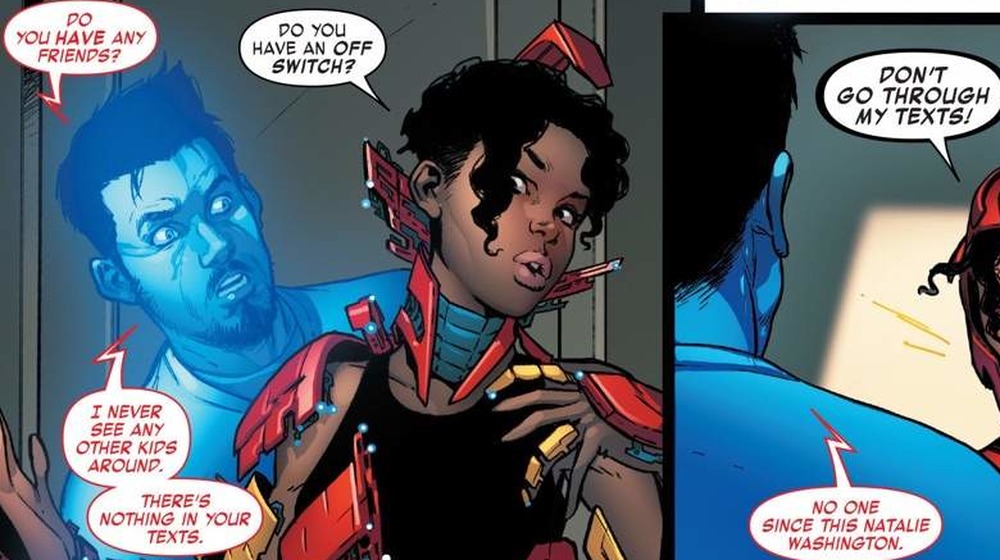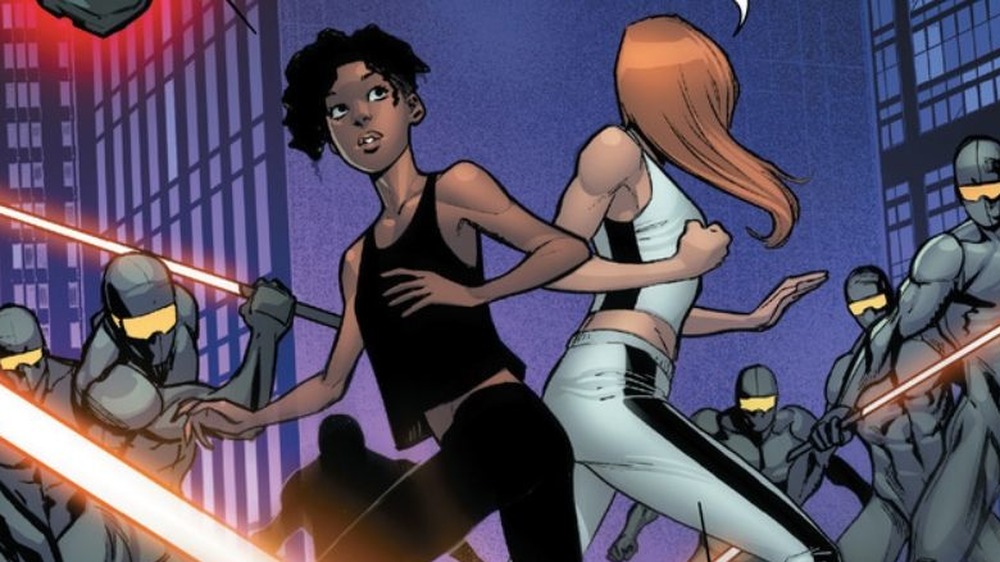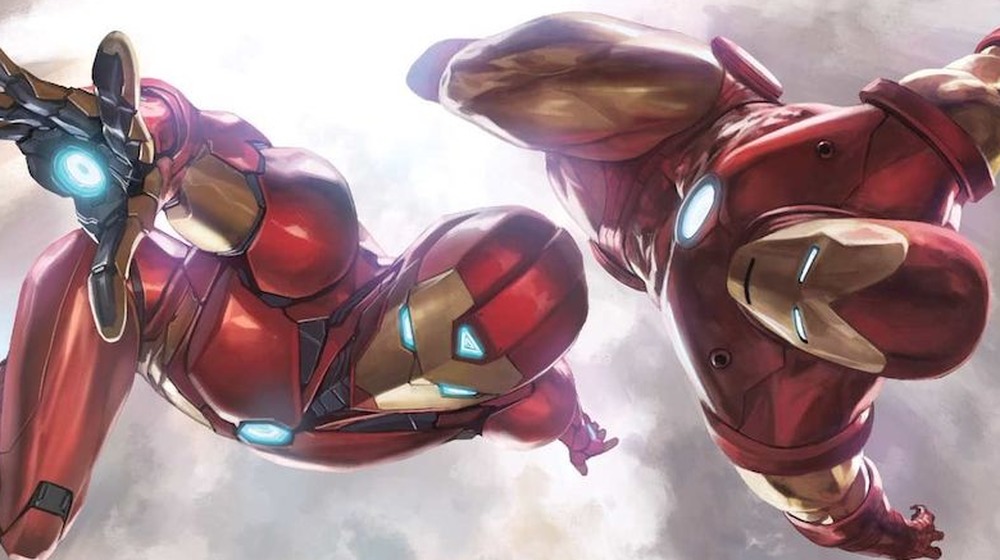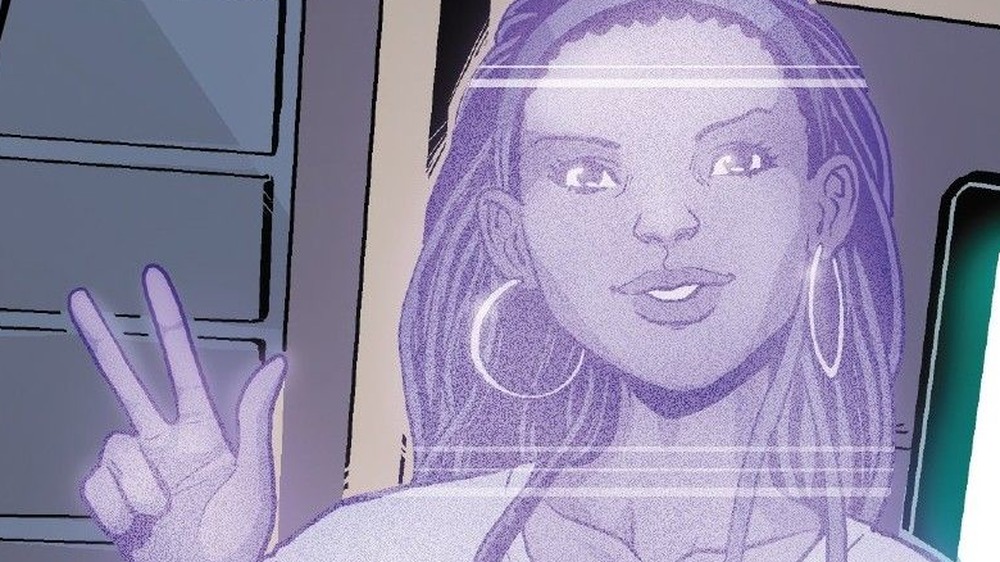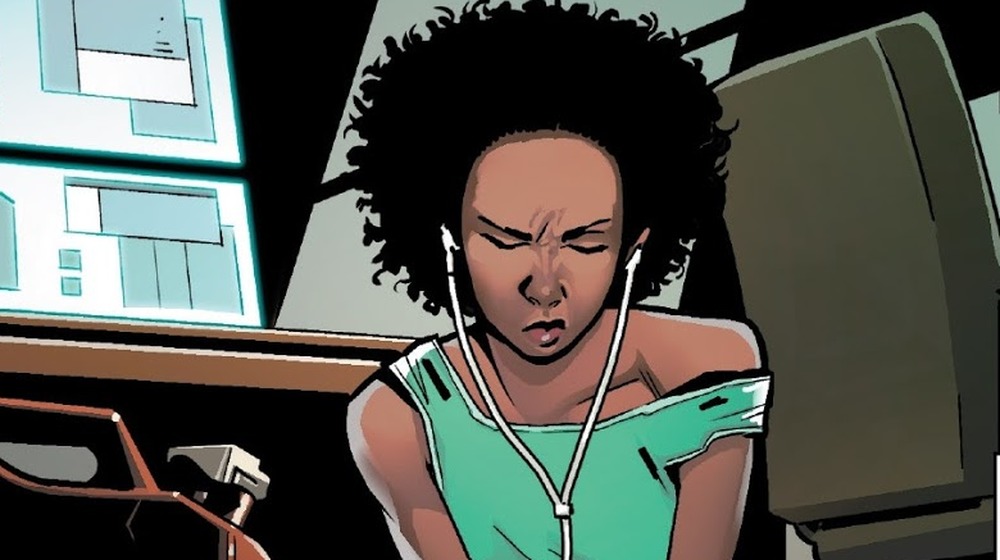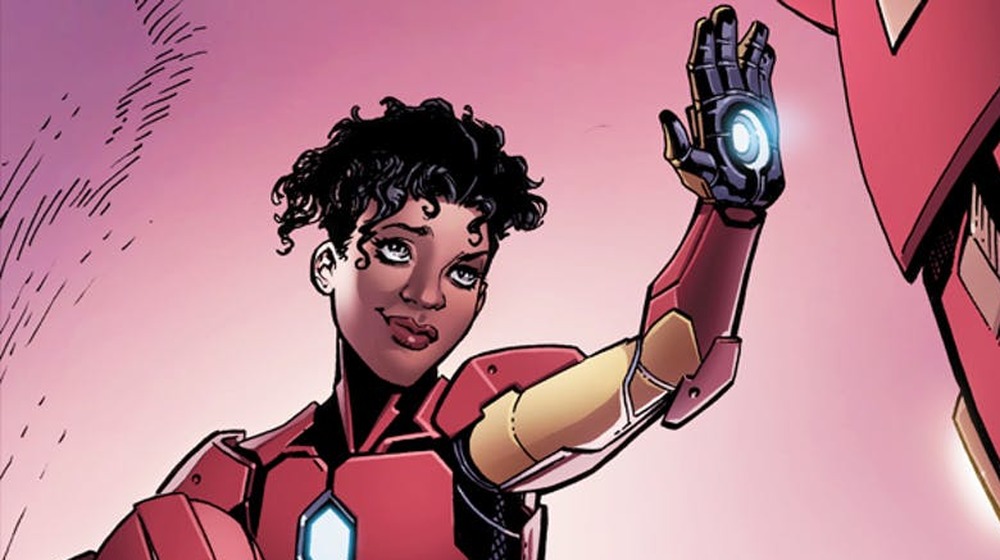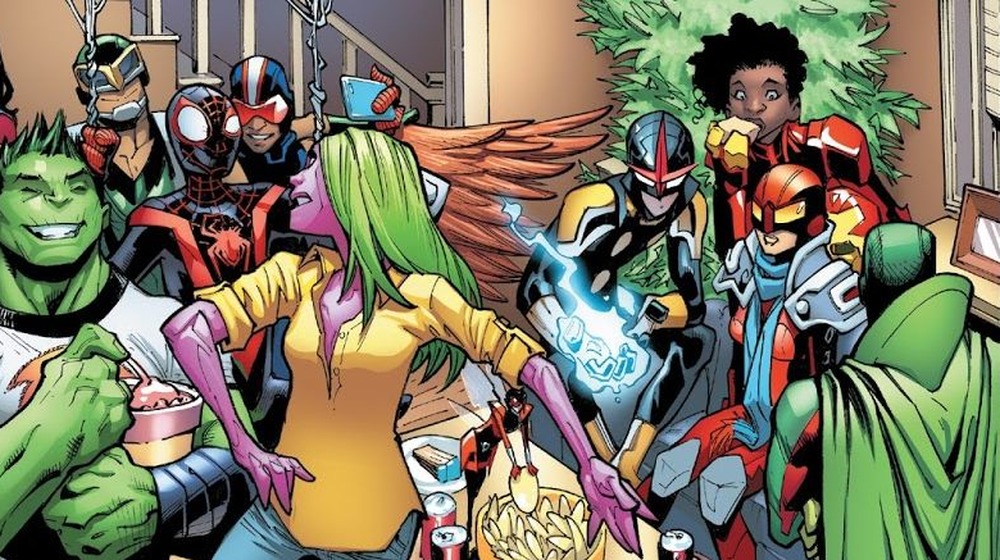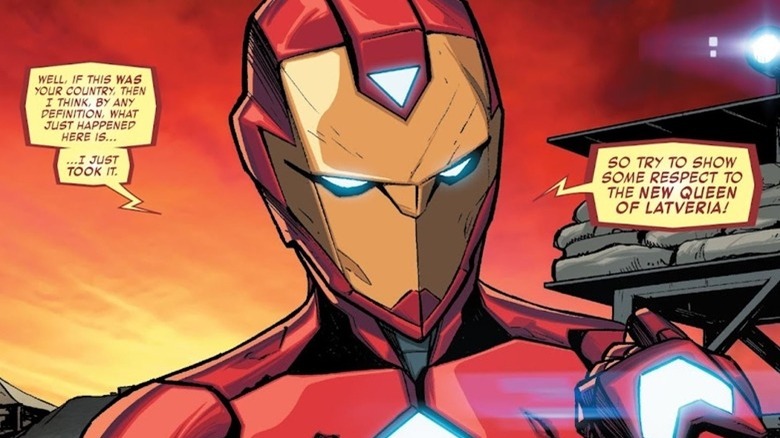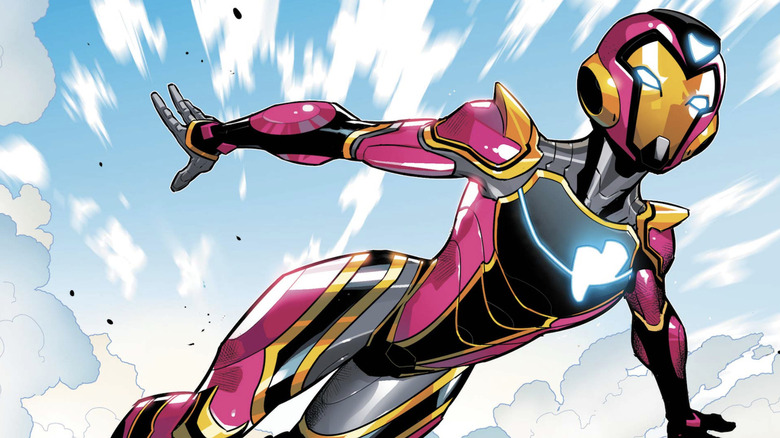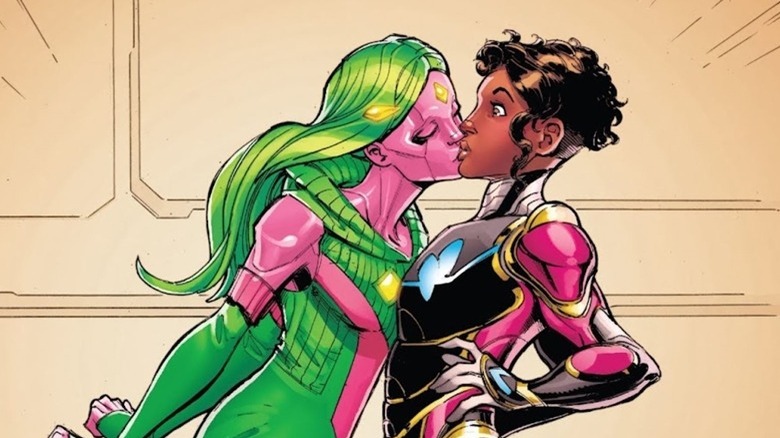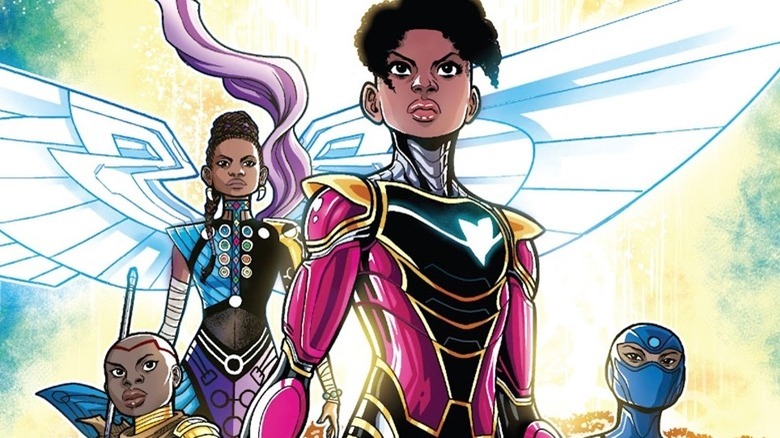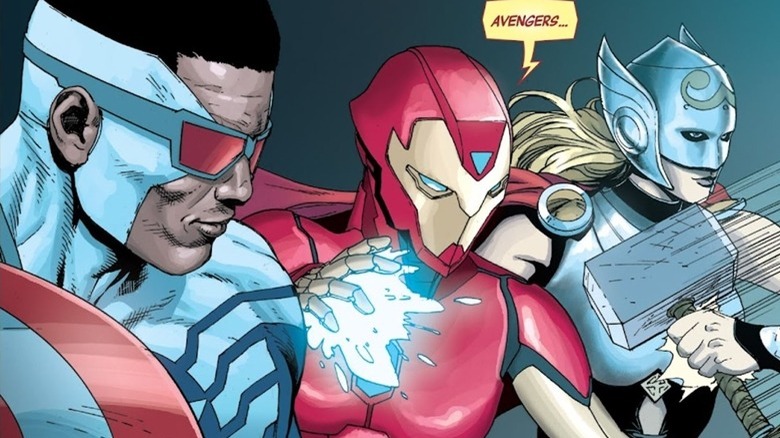The Untold Truth Of Marvel's Ironheart
During Disney's 2020 year-end Investors Day livestream, a number of exciting new Marvel projects were announced, and other projects in the works received new updates. Among that former category of newly announced projects was an "Ironheart" series on Disney+, with Dominique Thorn in the lead role. Fans were excited by the news, the prospect of seeing Ironheart in live action setting them abuzz. Though Ironheart hasn't been around very long in the comics — her first appearance was in "Invincible Iron Man" Vol. 2 #7 — she's quickly become a fan favorite. Created in 2015 by comic book writer Brian Michael Bendis and artist Mike Deodato and later revised by Eve Ewing and Kevin Libranda, Ironheart, better known as Riri Williams to her friends and family, made an immediate impact.
For as beloved as she's become, she's still so new that most fans outside of comic book fandom have never heard of her. Plenty may be wondering who she is in the wake of the news that she's getting her own show. Who is she? Here's the fascinating backstory of Riri Williams, a.k.a. Ironheart.
A reflection of our world
Ironheart came along at a time in which a number of other young, diverse characters, such as Miles Morales and Kamala Khan, were also stepping into prominent positions in the Marvel Comics lineup. Creator Brian Michael Bendis says that Riri taking over for Tony Stark, a.k.a. Iron Man, in the comics wasn't a premeditated move made to hit some imagined diversity quota. Instead, her creation came about organically. Speaking to TIME Magazine in 2016, Bendis explained, "We never had a meeting saying, 'We need to create this character.' It's inspired by the world around me and not seeing that represented enough in popular culture."
Like the other young heroes, Riri was created to be a more accurate reflection of the world in which we live. All of them, including Ironheart, show readers that anyone can be behind the mask. Anyone can be the hero. In an 2016 interview with EW, Bendis reflected on how superheroes have impacted us, and how Riri and the other Marvel Comics newcomers are changing minds about who can wear the cape when even five years prior to that, superheroes just weren't as influential as they are today. "This is so exciting to me, to my peers, and to our fellow readers that all of these walls are disappearing," he said. "They're not even being knocked down. Young kids don't even see them. Anyone could be these heroes."
A hero rises, but not without controversy
Unfortunately, taking a swing by making Riri Williams reflective of the current world led to the character courting some real-world controversies along with the praise.
While Ironheart adding further diversity to the Marvel Universe was praised by many, some bristled. Specifically, they were frustrated that the creator of the heroic 15-year-old girl of color was a white man: writer Brian Michael Bendis. The problem, according to some, was that Bendis could never truly know what it's like to grow up as a Black girl and thus could not truly capture Riri's inner life, no matter how pure his intentions may have been. Additionally, the conversation led others to discover that, at the time, Marvel was employing no Black women writers.
Shortly after, fans would again call out Marvel for misunderstanding teen girls, this time from an artistic perspective. In the hopes of driving sales of the new Iron Man series that saw Ironheart becoming the lead character, Marvel commissioned several variant covers, a fairly typical maneuver. Artist J. Scott Campbell provided one; unfortunately, the cover pose rubbed several the wrong way. They saw the image, which featured Riri in a crop top and low-slung pants, as inappropriately sexualizing the teen character. Marvel ultimately pulled the cover before the book hit shelves and offered a new Campbell piece, one that depicted Ironheart in her armor, holding her helmet.
The Punisher's bright mirror
At first blush, the idea of comparing Ironheart to the Punisher feels like an odd one. Frank Castle, after all, is a grown man while Riri William is a teenager. The Punisher served in years' worth of violent military campaigns. Ironheart began attending M.I.T. at thirteen. Castle murders others to achieve justice. Williams seeks significantly less violent solutions.
However, the two do have personal tragedy in common. Both lost important people in their lives when a picnic at the park became a shootout where innocent people died in the crossfire. In Punisher's case, he watched as a spray of gunfire killed his wife and two children; for Ironheart, it was her stepfather and her best friend. The former was especially painful as he died keeping Riri out of harm's way.
While these senseless tragedies motivated both, they also exposed the differences in their personalities and life experience. For Castle, it was the last straw, the moment that convinced him of society's inherent brokenness and that only violence could solve the problem of crime. For Williams, it fueled her creativity and drive, pushing her to develop an armor that would help her protect the vulnerable, not just punish wrongdoers. Riri's reaction to her stepdad and best friend's deaths both affirms Frank Castle's pain and disputes the necessity of his bloody "solution."
A literal super-genius
Ironheart is inspiring in other ways, too — like the fact she's a genius. Only 15 years old at the time of her introduction, she was tested and declared a certified super-genius at the age of five. As she grew older, she became obsessed with technology and engineering, forgoing socializing and friends in favor of working on her inventions and research instead. By age 11, she was attending classes at MIT — yes, the world-renowned Massachusetts Institute of Technology — on an academic scholarship. Like many kids her age in the Marvel Universe, particularly budding scientists and engineers, Riri was fascinated with billionaire playboy genius philanthropist Tony Stark. Unlike those kids, however, she had a personal connection to Iron Man: He'd saved her and her late stepfather from a Skrull attack when they invaded Earth.
So determined was Riri to follow in her idol's footsteps that, while attending classes at MIT, Riri secretly started working on building her own modified suit of armor like Iron Man, taking his Mark-41 design and reverse-engineering it before putting her own spin on the armor. She accomplished this by stealing parts from around campus, including from the robotics lab where she studied and worked. When campus police showed up at her dorm to confront her about it, she put on the armor and flew away, impulsively deciding to quit school to be a superhero.
Tony Stark's successor
When Tony Stark caught wind of Riri's exploits, he decided he had to meet the young super-genius who showed so much potential — and the same penchant for breaking the rules that had always driven him. After Riri quit school, she headed back home to Chicago to her mom's house to repair her suit, which had been damaged on a test run. Stark showed up on her doorstep — but far from scolding her for quitting school and fighting crime on her own, he came away deeply impressed by Williams' brilliance and commitment. Instead of dissuading her, he gave her his stamp of approval, supporting her in her decision to be a superhero. He even recruited her for his team in the second Marvel civil war, enlisting her aid in his conflict against Captain Marvel.
Unfortunately, Tony fell into a coma after battling Captain Marvel, so Riri decided to take up the mantle, choosing the name of Ironheart to honor her mentor's legacy while also being her own hero. That didn't mean she was completely without Stark's guidance, however. Ever the future planner, Tony had downloaded a duplicate of his consciousness into an A.I. framework, enabling himself to serve as a voice of (often unwelcome) wisdom in life and crimefighting.
And Tony mother-hens her
If you thought an A.I. version of Tony Stark would be less of a motormouth than the real thing, you'd be wrong. Similar to the dynamic between Stark and Peter Parker in the MCU, the Tony Stark-Riri Williams relationship in the comics is one of a mentor and his protégé. However, unlike the real Tony Stark, the A.I. version doesn't have to sleep, can technically be with Riri 24/7, and is able to access all her files effortlessly. The result is that their relationship sometimes mimics that of a father and adopted daughter, with Tony mother-henning Riri about things like her future, finding friends, and having a social life. And Tony being Tony, his A.I. snoops into Riri's personal life with good intentions but a lack of boundaries.
But their closeness has created a special bond between Tony and Riri where she's come to rely on him for personal advice as much as professional mentorship. During the first fight she lost, in fact, even as she was in the middle of fighting Will o' the Wisp, Riri still carried on a conversation she'd been having with Tony before and asked him what he thought she should do with her life. "What does your gut tell you?" he quipped. "Is it telling you to focus on this fight?"
Memorable mentors
Tony Stark may be Riri's greatest superhero mentor, but that doesn't mean he's been her only adviser in the superhero business. Riri has been lucky enough to also have a trio of amazingly powerful, capable women to guide her early on in the superhero game: Pepper Potts, who was moonlighting as the armored hero named Rescue; Tony's biological mother and former Stark Industries President, Amanda Armstrong; and even Mary Jane Watson. After the events of Marvel's second civil war, Amanda and MJ offered Riri Tony's labs to use as her own research facility and base of operations. Pepper also fought alongside Riri, providing an example early on of how to be a hero and wear the suit.
And one other famous Marvel face provided important mentorship to Riri at a turning point in her life: the vampire hunter known as Blade. When M.I.T. invited Riri back to school, the young superhero was torn by the decision. It was Blade who advised her to return and said she could more easily continue her search for Tony Stark's body from there. Ultimately, he was the reason she decided to accept M.I.T.'s offer.
Ironheart for a reason
There's a fascinating story behind Ironheart's name, in the comics as well as real life. According to co-creator Brian Michael Bendis, the superhero's name came out of an editors' discussion. They all agreed that "Iron Woman" was too old-fashioned, and "Iron Maiden" was a lawsuit waiting to happen. Then-Marvel CCO Joe Quesada was actually the one to come up with the name. "And Ironheart, coined by Joe Quesada, after I told him my planned story for Riri, speaks not only to the soul of the character but to the Iron Man franchise as a whole," Bendis explained in an interview with Wired. "Tony first put on the armor to save his heart. Riri puts it on for different reasons altogether but still heart-related."
The protection around Tony Stark's heart is literal; the protection around Riri's is emotional. In the comics, it's Tony's A.I. who suggests to Riri she give herself the name of Ironheart. It's symbolic of two impactful things that shaped Riri. The first was her best (and only) friend, Natalie Washington, and Riri's stepfather both being shot through the hearts and killed in a drive-by shooting when the three were picnicking in a park in Chicago. The name Ironheart is a tribute both to the nature of their deaths and to the metaphorical armor Riri has been building around her own heart ever since.
An homage to a friend
Not only is Riri's chosen superhero name partly an homage to her fallen friend, she specifically chose to honor Natalie's memory in another significant way. It's true Tony may be her guiding A.I., but he's an actual A.I. hologram that exists in the world, not the A.I. system that powers her suit. Tony opted to base his in-armor A.I. guidance system on his father's butler, Jarvis, or J.A.R.V.I.S. (Just Another Rather Very Intelligent System).
Riri, however, chose to base her own in-armor A.I. system on the memory of Natalie, her best friend who was tragically gunned down. Named N.A.T.A.L.I.E. (Neuro-Autonomous Technical Assistance and Laboratory Intelligence Entity), the line between A.I. construct and human is as blurred with Natalie as it is with A.I. Tony Stark. Natalie often pushes Riri to heroic deeds when she's conflicted about a situation, and it has brought them into conflict more than once. It's not unreasonable to think of a future in which Natalie's A.I. might one day power a suit on her own and become a full-fledged superhero rather than remaining in a support role for Riri.
The magic of 15
Brian Michael Bendis imagined Riri as a 15-year-old girl for a few reasons. He was drawn to that age because it represents one foot in childhood and one in adulthood, as he told EW. "I think there's something really magical about this age. You are in some cultures considered an adult, but there are whole parts of you that are still childlike," he explained. "You don't even know what you don't know yet."
Yet because Riri is a super-genius, she runs the risk of retreating from the world. It's something that happens, both in real life and with some characters from Marvel Comics, that the incredibly intelligent often find themselves growing bored with the world and with other people, so they compensate by isolating and getting too far inside their own heads. But because Riri is a teenager, as Bendis explained in a different TIME interview, she has her parents, specifically her mom after her biological father's death, to keep her engaged with the world. "I discovered, through research, that it is a thing that gifted children need desperately," said Bendis. "As we say in the story: high intellects, out of frustration, can sometimes retreat into their own world. This young woman has had that burden but she also has a grounded parent who helped her get to this point." So in many ways, it's Riri's mother who is the hero of the story.
She knows her own mind
Thanks to her mother, Riri isn't just well-grounded intellectually, but also emotionally and in her sense of self. Riri's been through a lot at her young age, and she still wants to do good and help others despite having so much taken from her. Despite her young age, she knows exactly who she is — or at least she knows exactly who she doesn't want to be. So much so that she even turned S.H.I.E.L.D. down flat. Her predecessor and mentor Tony Stark had often turned down the offer to work with S.H.I.E.L.D. over the years, whether through arrogance or a distaste for rules; at other points, S.H.I.E.L.D. turned him down due to his difficult nature. Still, Stark became the Director of S.H.I.E.L.D. at one point.
Riri, however, turned down S.H.I.E.L.D.'s offer of recruitment immediately because of her own morals. When S.H.I.E.L.D. commander Sharon Carter learned of her genius, she invited her to be a part of S.H.I.E.L.D., but Riri refused, believing that S.H.I.E.L.D. too often abused its own power. "I think S.H.I.E.L.D. might be the devil, but I'm sure you're a very nice person," she said, much to Carter's amazement. Most people in that (admittedly far-fetched) position would have jumped at the chance to be a superhero S.H.I.E.L.D. agent, but not Riri. She knows herself too well.
A Champion
Just because she didn't want to join S.H.I.E.L.D., that didn't mean Riri wasn't willing to join any team. In fact, she became a proud member of the Champions, the teenage superhero squad consisting of Ironheart, Miles Morales/Spider-Man, Kamala Khan/Ms. Marvel, Amadeus Cho/Hulk, Sam Alexander/Nova, Viv Vision, Nadia Van Dyne/Wasp, Joaquin Torres/Falcon, and Rayshaun Lucas/Patriot. The teens were all deeply disillusioned after the second civil war and struggling with the actions of the veteran superheroes, so they determined to form the Champions team and recruit other like-minded young heroes. Their mission statement was a perhaps naive but a noble one, to "enforce justice without unjust force" and to "win the right way — not with hate [or] retribution, but with wisdom and hope." Along with the Wasp and Cho, Ironheart helped build the Champions Mobile Bunker, a moving headquarters for the young team.
Even though they were teenagers, the Champions — and Ironheart with them — accomplished some pretty impressive things, such as tracking down the Hydra impostor Captain America and destroying Hydra sleeper cells across the United States. They even went up against Thanos, and it was Ironheart who charged him in her rage. She was easily beaten, but her fearlessness was notable. And when the team was collectively stricken with amnesia and scattered across the alternate dimension Weirdworld, it was ultimately Ironheart who brought the team back together.
A world leader pretend
It turns out there are worse things than having Doctor Doom as your country's dictator. For instance, one might find themselves living under the brutal reign of Lucia von Bardas. After von Bardas seizes power of Latveria and uses it as a base of operations to launch a terrorist attack on the United States, Ironheart feels she can no longer ignore the cyborg criminal's unethical and dangerous behaviors.
Egged on by S.H.I.E.L.D. — although it and other organizations refuse to sanction her behaviors — Ironheart travels to Latveria. Once there, she defeats von Bardas and declares herself the new Queen of Latveria. In the modern history of the small Eastern European nation, only the Fantastic Four before had attempted such a bold move.
Thankfully, this is no "absolute power corrupts absolutely" tale: Riri holds onto her newly declared role only long enough to broker peace between S.H.I.E.L.D. and Latverian military forces. With that in place, she abdicates her "throne," and Latveria begins the process of holding its first-ever free and fair democratic elections.
Ironheart 3.0
Nothing lasts forever, not even really excellent armor. Ironheart must learn that lesson firsthand while fighting alongside her fellow Champions against the Mad Titan Thanos. While executing an attack on the villain, Ironheart fails to take him by surprise; Thanos seizes the hero and strikes her with an energy blast that causes Riri's Iron Man-colored armor to fall to irreparable pieces.
Riri is immediately despondent in the wake of losing her armor. Thankfully, Viv Vision gives Ironheart an encouraging pep talk powerful enough to get Williams off the proverbial bench. Drawing on Earth and alien technology, as well as using her fights with the Chitauri for inspiration, Riri creates a new armor, christening it Ironheart 3.0.
In some ways, the loss of her previous armor turns out to be a blessing in disguise: It forces Riri not only to re-evaluate and make improvements over the armor she had been using, but also to take another step out of Tony Stark's shadow. Admiring him and accepting his mentoring are perfectly appropriate choices for someone Riri's age. However, the longer she's a superhero, the more she'll be able to stand independently. Redesigning her armor and employing a whole new color scheme is an essential step toward becoming her own hero, independent of the Iron Man legacy.
Matters of the heart make fools of geniuses, too
Navigating crushes in adolescence can be tricky business. Not all attractions are mutual, but no one wants to break anyone else's heart. Add in existing friendships, parents' rules, and your own crushes, and it doesn't take long for things to get complicated. Finally, teen superheroes must also consider how saying yes or no to a teammate's advances might affect the group's chemistry. Like it or not, it can be hard to trust someone to get your back when you just rejected their confessions of desire only a few hours before.
So when Viv Vision kisses Riri without much warning, Ironheart is understandably caught off guard and left struggling to process and convey her own feelings. The ensuing awkwardness leads Ironheart to avoid the team and missions, unsure how to deal with Viv and her feelings.
Ultimately, it takes the manipulation of the demonic Blackheart to force Viv and Riri to resolve their feelings. Under his sway, Ironheart attacks her teammates. Sensing some of the feelings Blackheart is twisting to control her teammate, Viv apologizes for kissing Riri without finding out if she'd be okay with it first. The apology breaks the demon's hold on Ironheart and the hero immediately pays it forward, using her nonlethal weapons to aid other corrupted Champions in breaking free.
When the dust settles, Riri finally explain that she can't return Viv's feelings, but hopes very much that the two remain friends.
A Wakandan connection
For fans who have already seen the trailer for "Wakanda Forever," Ironheart's connection to the African nation and its people is made very clear. In the comics, that connection isn't forged during Riri's debut, but in time, she does establish a similarly close bond in her four-color exploits.
It begins when, with Doctor Strange's help, Ironheart follows a lead that takes her to Wakanda. There she meets Shuri, Black Panther's sister, and their initial encounter proves chilly; still, the two are able to team up to overcome some shadow monsters. Eventually, the duo becomes a trio, with former New Warrior Silhouette joining up, hoping to find her brother Midnight Fire. Then, finally, it becomes a quartet, as Okoye joins the party.
This improvised team finds the Ten Rings, Midnight Fire, and Riri's apparent biological father attempting to harness Wakanda's Wellspring of Power for their own selfish ends. Using a mix of interpersonal skills, technology, and teamwork, Riri manages to stop the criminal enterprise's plan. For aiding Wakanda, both she and Silhouette receive the Circlet of Bast, the nation's highest honor. Additionally, Shuri reassures Riri she's welcome back any time.
Ironheart's connection to the country grows even stronger months later when she comes aboard to aid in Wakanda's space program, developing an armada to protect the nation and its allies off-planet.
The next generation's Big Three
The Avengers' Big Three, the superheroes that make up the team's backbone, are Thor, Captain America, and Iron Man. Your average citizen of Earth-616 might not be familiar with Triathlon or Firestar, but they'll recognize Thor on sight, no questions asked.
So when the people wearing the costumes change, it's a big deal in the Universe — and to fans of the comics, who frequently (and unfortunately) struggle with this. Given that, it means all the more when Marvel decides to go forward with it anyway.
In 2017's "Marvel Legacy," one of the stories in the anthology showcases a team-up of the Sam Wilson Captain America and the Jane Foster Thor. As seen with the MCU making similar commitments to a new Thor and Captain America, not all fans were in love with a man of color in the familiar stars and stripes or a woman wielding Mjolnir, but Marvel did it anyway.
Over the course of the story, readers meet the third member of the next generation's Big Three. Stepping into Iron Man's shoes was, of course, Ironheart. Given how long both Foster and Wilson had been part of the Marvel Universe, the inclusion of relatively new and teenage Riri is a tremendous expression of confidence in the character, making it clear that despite the likes of Rescue and War Machine, the true heir to Iron Man's legacy is Riri Williams.
